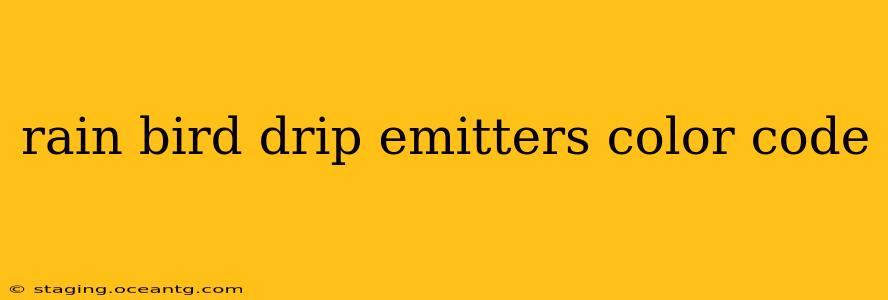Rain Bird, a leading name in irrigation, uses a color-coded system for its drip emitters. Understanding this code is crucial for efficient irrigation system installation and maintenance. This guide will break down the Rain Bird drip emitter color code, explaining the flow rates associated with each color and offering tips for choosing the right emitter for your needs.
What is the Rain Bird Drip Emitter Color Code?
Rain Bird's color-coding system simplifies emitter identification. Each color represents a specific flow rate (in gallons per hour, or GPH). This allows for quick visual identification of the emitter's output, essential for efficient water management and customized irrigation solutions. The color coding isn't universally consistent across all Rain Bird emitter types, so always refer to the product packaging or Rain Bird's official documentation for the most accurate information.
Common Rain Bird Drip Emitter Colors and Flow Rates
While specific flow rates can vary slightly depending on the emitter model and pressure, the general color-to-flow-rate association is as follows:
-
Gray: Often represents a low flow rate, typically in the range of 0.5 GPH. This is perfect for smaller plants and seedlings that require less water.
-
Blue: Usually indicates a medium flow rate, ranging from around 1.0 GPH to 1.5 GPH. Ideal for a wide variety of plants and shrubs.
-
Green: Typically corresponds to a higher flow rate, potentially ranging from 2.0 GPH to 4.0 GPH. Suitable for larger plants, trees, or areas needing more substantial watering.
-
Other Colors: Rain Bird may use other colors, or variations of these colors, for specific emitter types or flow rates. It is vital to always check the product packaging or specifications for the exact flow rate indicated by the color.
How to Choose the Right Rain Bird Drip Emitter Color
Selecting the appropriate drip emitter color depends on several factors:
-
Plant Type: The water requirements of different plants vary significantly. Research the water needs of your specific plants to determine the appropriate flow rate.
-
Soil Type: Sandy soil drains quickly, requiring higher flow rates compared to clay soils which retain moisture more effectively.
-
Climate: Hot, sunny climates often necessitate higher flow rates to compensate for faster evaporation.
-
Dripline Spacing: Emitter spacing influences the water delivery per plant. Closer spacing typically necessitates lower flow rates per emitter.
Remember that accurate selection is key to efficient and effective irrigation. Overwatering can lead to water waste and potential root rot, while underwatering can stunt plant growth.
What are the Different Types of Rain Bird Drip Emitters?
Rain Bird offers a variety of drip emitters, each designed for specific applications. These include:
-
Pressure Compensating Emitters: These maintain a consistent flow rate even with varying water pressure throughout the system.
-
Non-Pressure Compensating Emitters: These emitters' flow rate changes with water pressure fluctuations.
-
Adjustable Emitters: These allow you to fine-tune the flow rate to your exact needs.
-
In-Line Emitters: These emitters are installed directly into the dripline tubing.
-
End Cap Emitters: These are usually attached to the end of a dripline run.
What is the difference between a pressure compensating and a non-pressure compensating emitter?
Pressure compensating emitters maintain a consistent flow rate regardless of pressure changes in the irrigation system. This is beneficial for uneven terrain or systems with significant pressure variations. Non-pressure compensating emitters, on the other hand, deliver water at a rate proportional to the water pressure; a higher pressure will yield a higher flow rate and vice-versa. The choice depends on the specific needs and characteristics of the irrigation system.
How do I determine the GPH of a Rain Bird emitter if I don't know the color?
If the color isn't immediately identifiable, or if you're unsure of the color-code correspondence, refer to the Rain Bird product catalog or website for detailed specifications. The product label itself should also clearly state the flow rate. You can also usually find this information on the packaging.
By understanding the Rain Bird drip emitter color code and considering the factors outlined above, you can create a precisely tailored irrigation system for your plants, promoting healthy growth while conserving water. Remember to always check the specific product information for the most accurate details.
